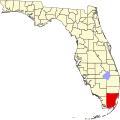Pinewood, Florida | |
|---|---|
 Location in Miami-Dade County and the state of Florida | |
 U.S. Census Bureau map showing CDP boundaries | |
| Coordinates: 25°52′14″N80°13′2″W / 25.87056°N 80.21722°W | |
| Country | |
| State | |
| County | |
| Area | |
• Total | 1.89 sq mi (4.90 km2) |
| • Land | 1.75 sq mi (4.54 km2) |
| • Water | 0.14 sq mi (0.36 km2) |
| Elevation | 7 ft (2 m) |
| Population | |
• Total | 17,246 |
| • Density | 9,854.9/sq mi (3,805.0/km2) |
| Time zone | UTC-5 (Eastern (EST)) |
| • Summer (DST) | UTC-4 (EDT) |
| ZIP Codes | 33147, 33150, 33167, 33168 (all - Miami) |
| Area code(s) | 305, 786, 645 |
| FIPS code | 12-57250 [3] |
| GNIS feature ID | 1867187 [4] |
Pinewood is an unincorporated community and census-designated place (CDP) in Miami-Dade County, Florida, United States. It is part of the Miami metropolitan area of South Florida. The population was 17,246 at the 2020 census. [2]
Contents
Most of Pinewood was originally a neighborhood of the City of Miami, annexed into the city in 1925. [5] With the arrival of the Great Depression, Miami gave up its jurisdiction and Pinewood became an unincorporated area of Miami-Dade County. [5]
